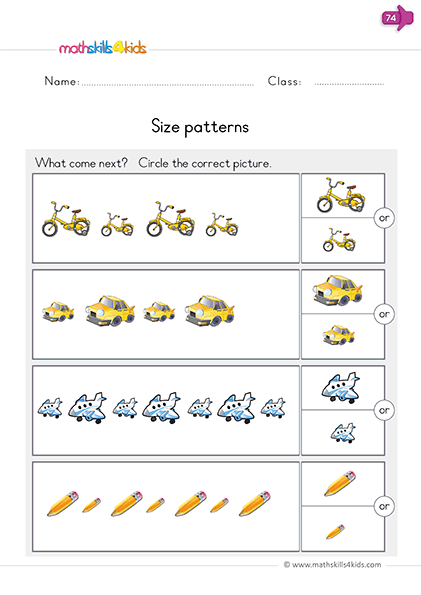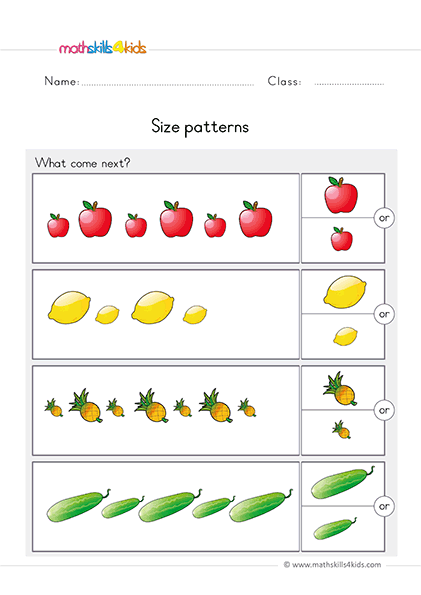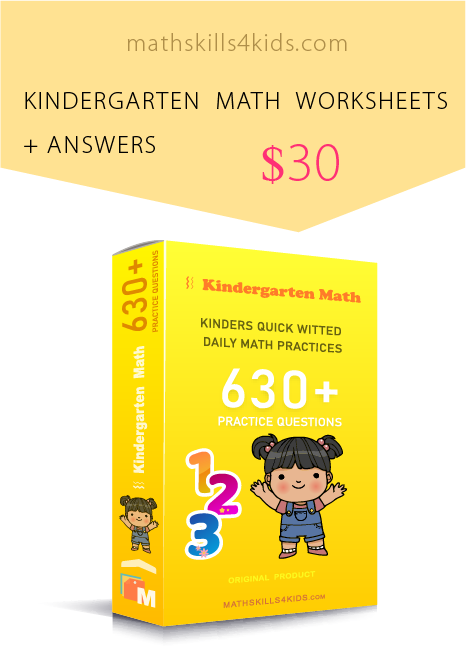Teaching patterns to kindergarteners: worksheets and activities
Incorporating patterns into everyday activities using visual aids and manipulatives are all super fun ways to teach patterns to kindergarteners.
So, in this section of MathSkills4Kids.com, you will find a variety of patterns worksheets and activities that will help your students learn how to recognize, create, and extend patterns using different materials and themes.
-
Patterns are an essential skill for young learners, as they help them develop their math and logic abilities, as well as their creativity and imagination.
However, teaching patterns in kindergarteners is fundamental as it forms the basis of many other math concepts like counting, sorting, and algebra. That is why its teaching process must be engaging and fun for kids.
So, stay on here and go through our fun and easy worksheets that will help you introduce patterns to your kids in an enjoyable way.
Fun and easy ways to introduce patterns to young learners with worksheets
Patterns are everywhere and a great way to help young learners develop their math and logic skills. Worksheets are a fun and easy way to introduce patterns to your students and boost their creativity and confidence.
Here are some tips on how to use worksheets to teach patterns:
- Start with simple patterns that use colors, shapes, or numbers. For example, you can ask your students to complete a pattern like red-blue-red-blue or circle-triangle-circle-triangle.
- Use different types of worksheets to vary the difficulty and challenge. For example, you can use cut-and-paste worksheets, fill-in-the-blank worksheets, or draw-your-own worksheets.
- Make the worksheets engaging and interactive using stickers, stamps, crayons, or other materials. You can also let your students create their own patterns and share them with their classmates.
- Review the patterns with your students and ask them questions to check their understanding. For example, you can ask them to identify the pattern unit, the pattern rule, or the next element in the pattern.
Worksheets are an excellent tool to introduce patterns to young learners, and they can make learning fun and easy. Try these tips in your next lesson and see how your students enjoy exploring patterns!
-
BROWSE THE WEBSITE
-
DOWNLOAD FREE WORKSHEETS
-
-
K- MATH TOPICS
- Learn to count up to 3
- Counting from 1 to 5
- Count up to 10
- Learn to count up to 20
- Counting to 100
- Skip counting
- Measurement
- Sum and difference
- Comparison
- Patterns
- Addition up to 5
- Addition up to 10
- Subtraction up to 5
- Subtraction up to 10
- 2D shapes
- Introduction to symmetry
- Position
- Fractions
- Time
- Classify
- Data and graph
- Probability
- 3D shapes
-
-
Start with simple patterns
Begin by showing your students examples of simple patterns, such as ABAB (red, blue, red, blue) or AAB (circle, circle, square).
You can use worksheets with pictures or shapes that follow a pattern and ask your students to identify and complete them. By identifying and completing patterns, your kids will gain critical thinking skills that will help them in all areas of their life.
You can also have them create their own simple patterns using stickers, stamps, or crayons. By so doing, they will develop the best problem-solving and critical-thinking skills.
-
Use visual aids and manipulatives
To make patterns more engaging and concrete for your students, you can use different kinds of visual aids and manipulatives, such as pattern blocks, beads, buttons, or pom-poms.
You can have your students sort them by color, shape, or size and then use them to make patterns. You can also have them copy or extend your patterns with the manipulatives.
-
Incorporate patterns into everyday activities
Have you noticed how your kids engage with math patterns daily without formal instruction? If yes, incorporating patterns into everyday activities will subsidize and uplift their everyday pattern learning.
You can help your students notice and appreciate patterns in their surroundings by pointing them out and asking them questions. For example, you can ask them to find patterns in their clothing, classroom decorations, or nature.
You can also have them make patterns with their body movements, such as clapping, jumping, or tapping.
-
Introduce more complex patterns as they progress
As earlier said, starting with simple ABAB or AAB patterns is better; you can gradually introduce more complex patterns as your kids progress.
As your students become more confident and proficient with simple patterns, you can challenge them with more complex ones, such as ABC (red, blue, green) or AABB (circle, circle, square, square).
You can also introduce them to different growing or repeating patterns, such as (1, 2, 4, 8) or (1-2-1-2-1-2).
You can use worksheets with more variety and difficulty in the pictures or shapes that follow a pattern and ask your students to identify and complete them. You can also have them create their own complex patterns using different materials or tools.
-
Encourage creativity and exploration
Encouraging your kids to explore and create patterns independently is the best way to build on their patterning skills.
You can provide them with various materials and tools that they can use to experiment and make patterns of their choice. The joy of discovering new patterns will build their confidence and enhance their problem-solving skills.
You can also encourage them to share their patterns with their classmates and explain how they made them. You can praise their efforts and creativity and ask them to reflect on their learning.
-
More exciting ideas to help your kindergarteners master patterns
Do you want to help your kindergarteners master patterns in a fun and easy way? Patterns are an essential skill for young learners, as they help them develop their logic, math, and creativity. Here are some exciting ideas to make patterns fun and engaging for your kids:
- Use colorful objects like beads, buttons, or blocks to create simple patterns like ABAB or AABA. Ask your kids to copy, extend, or complete the patterns. You can also challenge them to make their own patterns with the objects.
- Play pattern games with songs and movements. For example, you can sing "Head, Shoulders, Knees and Toes" and clap your hands in a pattern like clap-clap-pause or clap-pause-clap. Ask your kids to follow along and repeat the pattern. You can also use other songs or movements like jumping, stomping, or waving.
- Make pattern art with stickers, stamps, or cut-out shapes. Give your kids a sheet of paper and some stickers, stamps, or shapes of different colors and sizes. Ask them to make a pattern with them on the paper. You can also give them a pattern template and ask them to fill it in with stickers, stamps, or shapes.
- Read books about patterns with your kids. Many books introduce patterns in a fun and colorful way. Some examples are "Pattern Fish" by Trudy Harris, "A-B-A-B-A: A Book of Pattern Play" by Brian P. Cleary, and "Pattern Bugs" by Trudy Harris. You can also ask your kids to find patterns in the illustrations or make up their own stories using patterns.
Enhance kids logical reasoning skill – pattern recognition worksheets for kinders
Patterns worksheets for kindergarten greatly enhance kid’s logical reasoning skill.
Here, kid’s will need to use their reasoning skills to make predictions and logically connect the occurrence of each pattern from one to the other.
In our pattern recognition worksheets for prekinders, kids will come across new and simple patterns, which repeats with only one or two elements. It is for this reason that our pattern worksheets for kindergarten has designed colorful and visual patterns for kids to easily observe and predict what comes next.
Example: what comes next? Circle the correct picture
It’s very easy to identify the smallest bee. This is because the difference in their sizes is very clear. Following in each case, circle the one that is smallest, kids are meant to circle only the object that is very tiny compared to the others, such as →

If we look keenly, we’ll notice that the sequence of shapes goes one after the other, as follows;
Star → triangle → star → triangle → star.
so, what comes next?
From the smaller box, you’ve got to circle the correct picture, what comes next? i.e. star or triangle?
Following the pattern of shapes, we’ll realize that after the star, comes the triangle. If the sequence ends in star, our next shape will of course be the triangle, so we circle thus Triangle.
Wow! It’s just soooo perfect and simple
-
Thank you for sharing the links of MathSkills4Kids.com with your loved ones. Your choice is greatly appreciated.
Teaching patterns to your kindergarteners can be a fun and rewarding experience for you and your students. Using worksheets and activities appropriate for their level and interest, you can help them develop their pattern recognition and creation skills.
You can also foster their curiosity and imagination by exposing them to different patterns in their environment and letting them explore and create their own. By doing so, you will not only teach them a vital math concept but also prepare them for future learning.
Happy teaching!
Useful links
Pattern Recognition Worksheets | kidzone.ws:
https://www.kidzone.ws/prek_wrksht/math-readiness/patterns.htm
Kindergarten Pattern Worksheets - Printable | K5 Learning:
https://www.k5learning.com/free-preschool-kindergarten-worksheets/patterns





